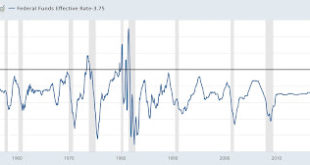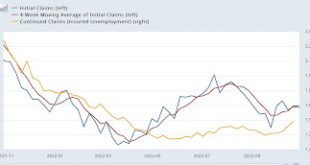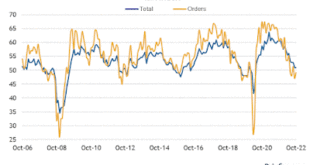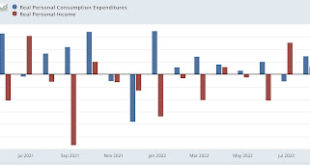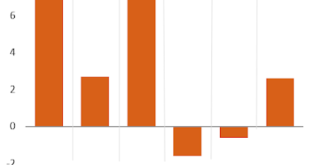October jobs report: late cycle deceleration and deterioration – by New Deal democrat With the sharp increases in interest rates, and the complete stalling of real consumer spending measured YoY, since early this year I have expected employment to follow suit, decelerating over time to a stall. And the three month average in employment gains since February decelerated from over 500,000 to 372,000 through September. Because jobless claims,...
Read More »The Fed appears determined to cause a Volcker-like recession
The Fed appears determined to cause a Volcker-like recession – by New Deal democrat Yesterday the Fed raised rates another 0.75%. In the past 8 months, the Fed has raised rates a total of 3.75%. This is one of the steepest increases in interest rates ever, only exceeded by the pace of the two 1970s oil shocks (1974 and 1979) and Volcker’s inflation jihad of 1981, as shown in the below graph of the YoY% change in the Fed funds rate. Note...
Read More »Jobless claims: steady as she goes
Jobless claims: steady as she goes by New Deal democrat [ Special programming note: yesterday’s Fed action, and more important the statements made afterward, merit special attention. I will put up a special post on that later today.] Initial jobless claims remained at their recent low level, down -1,000 from one week ago to 217,000. The 4 week average declined -500 to 218,750. Continuing claims, which lag slightly, rose 47,500 to a 7 month...
Read More »Are you Better Off in 2022 than You Were in 2010?
[embedded content] I can tell you now, I know I am better off now than then. I believe most of us are better off now. In 2010, I was working out of state after renting a room from Charlie in Cazenovia, NY. I was working for the Germans running a purchasing department. In 2010 and after several years of unemployment, a Republican Congress decided to end unemployment. Basically, they tossed people who were out of work, had no healthcare, or monthly...
Read More »Manufacturing, construction, and job openings all show an economy under stress
Manufacturing, construction, and job openings all show an economy under stress – by New Deal democrat As usual, we begin another month with important manufacturing and construction data. Additionally, the JOLTS report for September was also released. The ISM manufacturing index has a very long and reliable history. Going back almost 75 years, the new orders index has always fallen below 50 within 6 months before a recession, and in three...
Read More »Personal income and spending for September
While I was away . . . Personal income and spending for September Real personal spending increased +0.3% in September, while real income increased less than 0.1%, rounding to unchanged: Since May 2021, after the last round of pandemic stimulus expired, real spending is up 3.3%; but real income is down -2.0%: Real personal spending had stalled in late spring and summer, but in the last two months – aided by revisions – has increased...
Read More »New Deal democrat’s weekly indicators for October 24 – 28
Weekly Indicators for October 24 – 28 at Seeking Alpha – by New Deal democrat My Weekly Indicators Post is up at Seeking Alpha. Slowly even more indicators are deteriorating in several timeframes. As usual, clicking over and reading will bring you up to date on the economy, and bring me a little reward for my efforts. “New Deal democrat’s weekly indicators for October 17 – 21,” Angry Bear, angrybearblog....
Read More »Global Housing Price Slump and Other Economic Issues Early 2023
“A global house-price slump is coming,” The Economist, edited. I find this article to be interesting although I do not agree with much of it. Prices are an issue; but so are interest rates. Much of the costs of housing can also be from house manufacturing waste. I was watching my new home being built. The scrap is horrendous. The do-overs because of a lack of critical path are numerous. Quality is inspected into homes and not built into a home. I...
Read More »Q3 GDP: good news for now, bad news for the future
Q3 GDP: good news for now, bad news for the future – by New Deal democrat I have to keep this note brief, since I am on the road. As you presumably already know, real GDP was positive for the Third Quarter, up 2.6% at an annual rate: Subject to revisions in the next several months of course, but for the moment, this puts to rest ideas that the US economy was in a recession earlier this year, since the decline was very shallow and not...
Read More »Understanding Inflation using Gasoline Prices
Seems that gas, fuel, gasoline is being used as a marker to understand just how horrible we have it as a result of the current inflation. It’s just sooooooooooo terrible. I’ll just say this. As a marker of inflation and our personal economic experience all it shows is how terrible we are at remembering. Unfortunately for us, such a bad memory leads us to terrible voting decisions. Though, it does allow for easy emotional manipulation of the citizenry...
Read More » Heterodox
Heterodox

